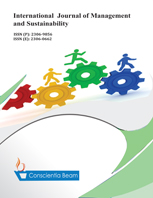The effect of ESG activities on financial performance: The moderating effect of debt ratio
DOI:
https://doi.org/10.18488/11.v13i2.3622Abstract
This study examined the effect of environmental, social, and governance (ESG) management on corporate performance. We collected sample data on KOSPI-listed companies in 2021 using ESG ratings released by the Korea Corporate Governance Service. The system of ratings was segmented into three distinct categories for the purpose of analysis, namely the environment, society, and governance. An empirical investigation was conducted to determine how ESG ratings and separate ratings (E, S, and G ratings) affect financial performance. We also examined the moderating impact of the debt ratio on the association between ESG ratings and financial performance to enhance the explanatory strength of this relationship. The results indicated that ESG ratings and E and S ratings are positively related to financial performance, and the debt ratio has a negative moderating effect on the link between ESG ratings related to environmental aspects and financial performance. The findings indicate that firms need ESG management to improve financial performance. ESG ratings can be utilized to show the effects of environment-focused management, sustainability, and CSR initiatives on financial performance. Additionally, the moderation effect of the debt ratio in this study clearly demonstrates the connection between ESG rating and financial performance. Our analysis also demonstrates that organizations with high debt ratios and a lack of resources to pursue ESG are unable to devote a significant amount of time and resources to ESG management.

